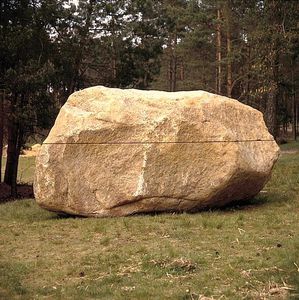Ulrich Eller
'My works are a sort of compositional game, not in the sense of registers, chords and tempos, but as a dialogue between material, form and sound.'
(Ulrich Eller)
Artistic development
Ulrich Eller is a sculptor, illustrator and sound-artist who belongs to the first generation of the then nascent genre of ?Klangkunst?. Born in Leverkusen in 1953, he is a professor at the Braunschweig School of Fine Arts and lives on a large former farmstead in Dithmarschen on the North Sea. His art reflects a deep attachment to nature. His drawings and sculpture are immediately accessible and avoid high-tech pretensions. He fills huge boulders, empty canisters, weather balloons and bugles with sound, but he also causes goose down to dance in the air. His work also has nautical overtones, combining conch shells of every sort with street and urban noise. His current works, such as Gelenkte Resonanz ('Channelled resonance', 2008) in Flensburg or Hör Mal ('Listen', 2009) in the Hermanshof landscape park in Springe-Völksen near Hanover, are continuously resounding outdoor installations composed of stainless steel and aluminium.
Modified instruments
Eller studied with Herbert Kaufmann at the Berlin University of the Arts. There he perfected the drawing skills that he would later apply in his abstract musical notation ? a unique phenomenon in the sound-art genre. Since the late 1970s he has also experimented with discarded instruments and has photographed landscapes and boulders. In the 1980s he was active as a blues guitarist in Berlin. He explored instruments and their interiors, probing the interaction of vibration modes and resonating bodies, activators and amplifiers. He sawed up the frames of pianos and played music on the materials thus obtained. Sport halls, skating rinks and empty factories now became his concert venues. Until well into the 1990s he placed piano frames with complete sets of strings on stage and amplified them to create new sound spaces. At these same concerts, valuable electric guitars were placed on the floor and played with pebbles.
Concert stage vs. Everyday life
Eller is a passionate collector of seashells and flotsam. He even employs minuscule shells as resonating chambers and natural amplifiers. He is aware that the size and material of a space will determine its distinctive sound. In the early 1990s he abandoned the concert stage and discovered new spaces where his sonic universes could freely unfold. In Außerhalb ('Outside'), a work created at the Chicago Cultural Center in 1995, he combined the exterior of the street with the gallery space, using the gallery's window as a filter. Seeing and listening, motion and sound events became disconnected. Glass receptacles inserted into a wall object were equipped with tiny loudspeakers that functioned as resonators, emitting distorted sounds from the street. Eller disconnected normal seeing and listening and shifted street noise into the interior volumes of the small receptacles. Streets in Chicago, Kyoto and Montréal provided this peripatetic artist with pulsations reflected from buildings, to which he then supplied artistic commentary.
Material research
Ship containers, snare drums, metal cabinets, paper bags, seashells, pebbles and boulders, rakes, pianos, electric guitars and miniature Korean loudspeakers: these are the materials Eller has used in the past to create his objects. He is interested in altering and remodelling musical instruments. Most of all he attaches sensors to the tines of rakes and other tools. These objects are then used to scrape the surfaces of windowpanes, boulders and paper and to translate them into sound. Eller transforms interior spaces, coaxing from each space its own distinctive sound. He is an artist and researcher who discloses previously unknown realities and deals with the relations between mass and sound, interior and motion.
Landscape
In the 1990s Eller selected a roughly ten-ton monolith of heavy gold-brown granite near Bad Segeberg for its colour and sculptural properties and turned it into a resonating object. The boulder was split laterally along its horizontal axis to create a piece of sculpture: the Hörstein ('Hearstone'). Grooves for loudspeakers were milled into the surfaces thus obtained, after which the two halves were rejoined. The line passed across the surface of the stone like a crater. Noise from the masonry saw provided the sonic material, which became the basis of a composition. Thus the history of the stone's bifurcation, which lasted several days, resounds from its interior. Since then the object has lured many visitors to the Springhornhof landscape park on the Lüneberg Heath. All of them, young and old alike, touch the Hörstein to see whether it really is a large heavy boulder whose sounds make it seem so light.
Christoph Metzger
produced by
Deutscher Musikrat gemeinnützige Projekt-
gesellschaft mbH
Förderprojekte
Zeitgenössische Musik
Weberstraße 59, 53113 Bonn
P 02 28 - 20 91 170
F 02 28 - 20 91 200
E zm@musikrat.de
curators of the exhibition
Stefan Fricke,
Johannes S. Sistermanns

